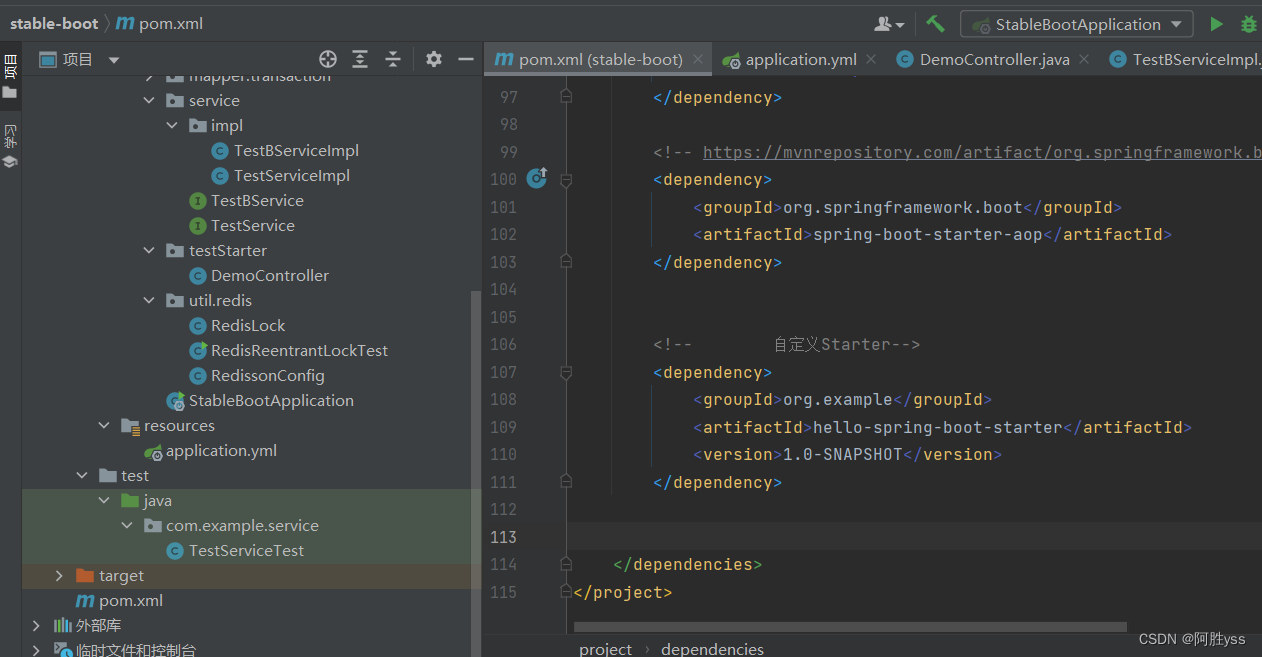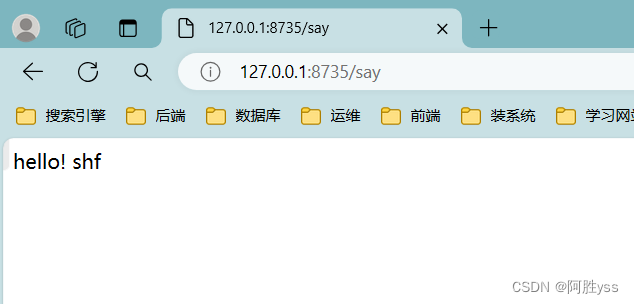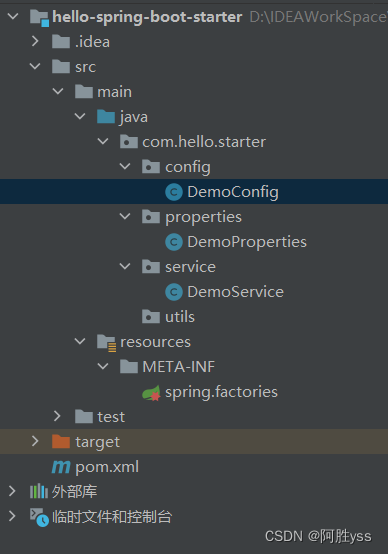- 1Python实现图的最短路径算法_python 图 最短路径
- 2单点登录(SSO)看这一篇就够了
- 3修改fstab导致UBUNTU无法启动的解决办法_linux开机显示systemd-fstab-generator failed with exit
- 4性能测试(三)----loadrunner的使用_loadrunner压力测试500并发
- 5如何补丁1个文件(linux diff patch)_patch: **** only garbage was found in the patch in
- 6upload-labs·文件上传(靶场攻略)
- 7安卓开发投屏反控实现方式_android投屏功能开发
- 8NLTK:自然语言处理的巫师,Python中的语言大师!
- 9利用android studio制作简单的QQ的注册、登录、忘记密码的页面_android studio注册qq页面
- 10H5页面在浏览器中跳转APP的方式/URL Scheme/Universal Link_url scheme前端
spring boot 自定义starter示例
赞
踩
springboot 约定规范
Starter项目的命名规范
建议自定义的starter 以 xxx-spring-boot-starter 命名,官方的Starter一般都是以spring-boot-starter-为前缀。这样做的目的是为了避免与官方或其他第三方提供的Starter产生冲突或混淆。
Starter项目的结构规范(重要)
最核心的是 Spring Boot自动装配文件
作用: 用来指定我们的自动配置类,让Spring Boot能够在启动时自动扫描并加载它。
名称必须为 spring.factories
路径必须为resources/META-INF/spring.factories 这是springboot的约定规范,不遵守一律失效。
注意!!!:springboot 2.7 版本有所变化,具体请查看springboot官网。
hello-spring-boot-starter
pom.xml
依赖说明
- spring-boot-configuration-processor : 编译时依赖 可以帮助我们生成属性类和配置元数据,并且设置为可选依赖,避免传递给其他项目。
- spring-boot-starter : 基础依赖 提供了Spring Boot核心功能和默认配置
<?xml version="1.0" encoding="UTF-8"?> <project xmlns="http://maven.apache.org/POM/4.0.0" xmlns:xsi="http://www.w3.org/2001/XMLSchema-instance" xsi:schemaLocation="http://maven.apache.org/POM/4.0.0 http://maven.apache.org/xsd/maven-4.0.0.xsd"> <modelVersion>4.0.0</modelVersion> <!-- 用户依赖必须指定的参数 --> <groupId>org.example</groupId> <artifactId>hello-spring-boot-starter</artifactId> <version>1.0-SNAPSHOT</version> <properties> <!-- jdk版本--> <java.version>1.8</java.version> <maven.compiler.source>8</maven.compiler.source> <maven.compiler.target>8</maven.compiler.target> </properties> <dependencies> <!-- 基础依赖 提供了Spring Boot核心功能和默认配置 --> <dependency> <groupId>org.springframework.boot</groupId> <artifactId>spring-boot-starter</artifactId> <version>2.7.18</version> </dependency> <!-- 编译时依赖 可以帮助我们生成属性类和配置元数据,并且设置为可选依赖,避免传递给其他项目。--> <dependency> <groupId>org.springframework.boot</groupId> <artifactId>spring-boot-configuration-processor</artifactId> <version>2.7.18</version> <optional>true</optional> </dependency> </dependencies> </project>
- 1
- 2
- 3
- 4
- 5
- 6
- 7
- 8
- 9
- 10
- 11
- 12
- 13
- 14
- 15
- 16
- 17
- 18
- 19
- 20
- 21
- 22
- 23
- 24
- 25
- 26
- 27
- 28
- 29
- 30
- 31
- 32
- 33
- 34
Starter项目的属性类
在创建一个自定义的Starter项目时,我们需要编写一个属性类,用来定义我们要集成的功能模块所需的配置项,并且使用@ConfigurationProperties注解来指定用户配置文件中的前缀。
package com.hello.starter.properties; /** * * 描述:配置信息 实体 * @author yss * @date 2024/5/1 */ import org.springframework.boot.context.properties.ConfigurationProperties; @ConfigurationProperties(prefix = "demo") // 指定 用户配置文件中的前缀 public class DemoProperties { private String sayWhat; private String toWho; public String getSayWhat() { return sayWhat; } public void setSayWhat(String sayWhat) { this.sayWhat = sayWhat; } public String getToWho() { return toWho; } public void setToWho(String toWho) { this.toWho = toWho; } }
- 1
- 2
- 3
- 4
- 5
- 6
- 7
- 8
- 9
- 10
- 11
- 12
- 13
- 14
- 15
- 16
- 17
- 18
- 19
- 20
- 21
- 22
- 23
- 24
- 25
- 26
- 27
- 28
- 29
Starter项目的业务功能类
在创建一个自定义的Starter项目时,我们需要编写一个或多个业务功能类,用来实现我们要集成的功能模块的具体逻辑。
package com.hello.starter.service; /** * @author yss * @date 2024/5/1 */ public class DemoService { public String sayWhat; public String toWho; public DemoService(String sayWhat, String toWho){ this.sayWhat = sayWhat; this.toWho = toWho; } public String say(){ return this.sayWhat + "! " + toWho; } }
- 1
- 2
- 3
- 4
- 5
- 6
- 7
- 8
- 9
- 10
- 11
- 12
- 13
- 14
- 15
- 16
- 17
Starter项目的自动配置类(重要)
在创建一个自定义的Starter项目时,我们需要编写一个自动配置类,用来根据属性类和业务功能类,创建相应的Bean对象。Springboot自动配置原理源码解读
- @EnableConfigurationProperties : 启用属性类,并将其注入到配置类中。
- @ConditionalOnProperty: 判断用户配置文件中是否有相应的配置项,存在并且符合期望则满足条件
- @Configuration : 标识这是一个配置类,用来创建和注册Bean对象。
- @Bean: 根据属性类和业务功能类,创建相应类型的Bean对象,并注册到应用上下文中。
- @ConditionalOnClass: 判断业务功能类是否存在
package com.hello.starter.config; import com.hello.starter.properties.DemoProperties; import com.hello.starter.service.DemoService; import org.springframework.beans.factory.annotation.Autowired; import org.springframework.boot.autoconfigure.condition.ConditionalOnProperty; import org.springframework.boot.context.properties.EnableConfigurationProperties; import org.springframework.context.annotation.Bean; import org.springframework.context.annotation.Configuration; /** * @author yss * @date 2024/5/1 */ @Configuration // 标识这是一个配置类,用来创建和注册Bean对象。 //启用属性类,并将其注入到配置类中。 @EnableConfigurationProperties(DemoProperties.class) // 判断业务功能类是否存在 @ConditionalOnClass(DemoService.class) // 判断用户配置文件中是否存在指定的属性(isopen), // 如果存在并且值与期望相符, 则满足条件(开启相应功能)。 @ConditionalOnProperty( prefix = "demo", name = "isopen", havingValue = "true" ) public class DemoConfig { @Autowired private DemoProperties demoProperties; // 根据属性类和业务功能类,创建相应类型的Bean对象,并注册到应用上下文中。 @Bean(name = "demo") public DemoService demoService(){ return new DemoService(demoProperties.getSayWhat(), demoProperties.getToWho()); } }
- 1
- 2
- 3
- 4
- 5
- 6
- 7
- 8
- 9
- 10
- 11
- 12
- 13
- 14
- 15
- 16
- 17
- 18
- 19
- 20
- 21
- 22
- 23
- 24
- 25
- 26
- 27
- 28
- 29
- 30
- 31
- 32
- 33
- 34
- 35
- 36
- 37
Starter项目的自动装配文件(重要)
在resources/META-INF目录下创建一个名为spring.factories的文件,用来指定我们的自动配置类,让Spring Boot能够在启动时自动扫描并加载它。以下是一个示例:
#-------starter自动装配---------
org.springframework.boot.autoconfigure.EnableAutoConfiguration=\
com.hello.starter.config.DemoConfig
- 1
- 2
- 3
打包发布
执行 mvn clean install 命令 一个自定义的starter就完成了。
做完上面这几步,我们自定义Starter就完成了,下面我们来测试一下
引入依赖
在我们需要的项目中引入依赖。
<!-- 自定义Starter-->
<dependency>
<groupId>org.example</groupId>
<artifactId>hello-spring-boot-starter</artifactId>
<version>1.0-SNAPSHOT</version>
</dependency>
- 1
- 2
- 3
- 4
- 5
- 6

application.yml
demo:
# 允许 demo作为bean注入IOC容器 一定要指明 isopen 不然项目无法启动
isopen: true
say-what: hello
to-who: shf
- 1
- 2
- 3
- 4
- 5
DemoController.java
package com.example.testStarter; import com.hello.starter.service.DemoService; import org.springframework.web.bind.annotation.RequestMapping; import org.springframework.web.bind.annotation.RestController; import javax.annotation.Resource; /** * @author yss * @date 2024/5/1 */ @RestController public class DemoController { @Resource(name = "demo") private DemoService demoService; @RequestMapping("/say") public String sayWhat(){ return demoService.say(); } }
- 1
- 2
- 3
- 4
- 5
- 6
- 7
- 8
- 9
- 10
- 11
- 12
- 13
- 14
- 15
- 16
- 17
- 18
- 19
- 20
- 21
- 22
- 23
启动项目并且运行

ok了!!




